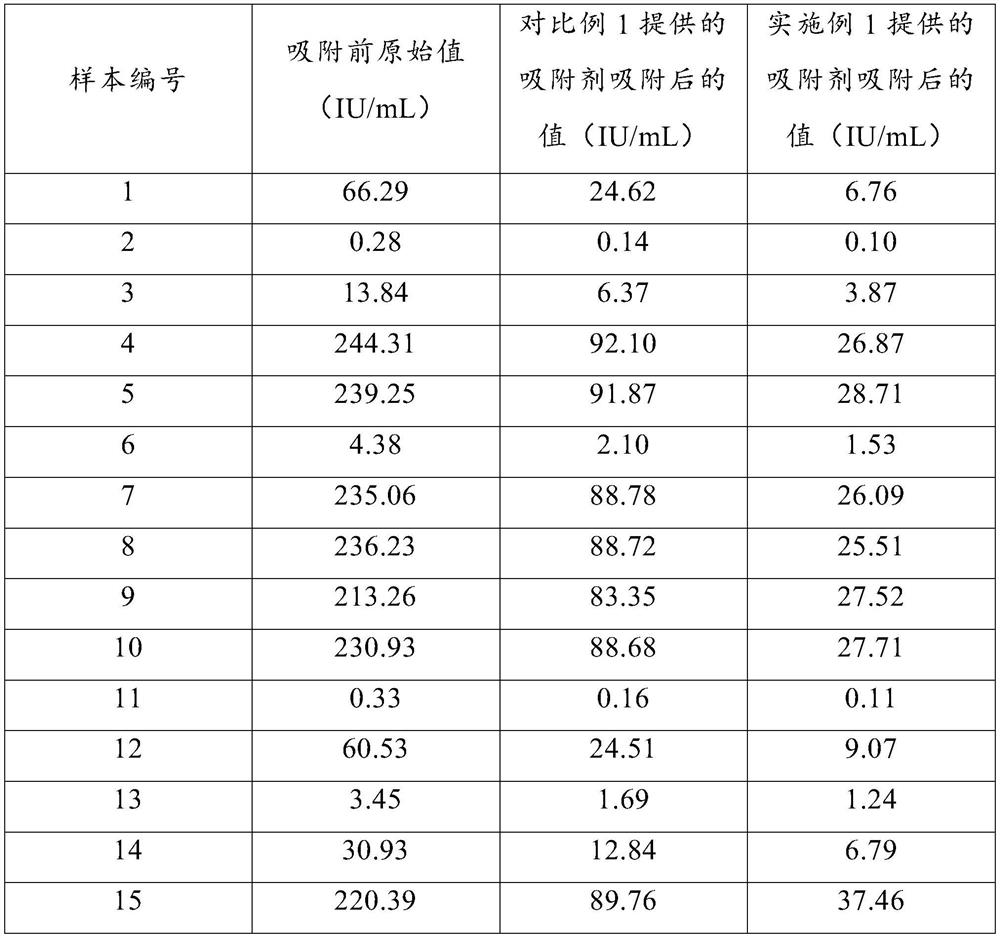Hepatitis B virus adsorbent based on nanostructure as well as preparation method and application of hepatitis B virus adsorbent
A hepatitis B virus and nanostructure technology, applied in the field of biomedical adsorption materials, can solve the problems of difficult ligand surface size and geometry, affecting ligand recognition ability, high immunogenicity of antibodies, etc., to achieve reduced content, high Practical application value, efficient adsorption effect
- Summary
- Abstract
- Description
- Claims
- Application Information
AI Technical Summary
Problems solved by technology
Method used
Image
Examples
preparation example Construction
[0029] The invention provides a method for preparing a nanostructure-based hepatitis B virus adsorbent, comprising the following steps:
[0030] S1. Synthesis of DNA nanomaterials;
[0031] S2. After recovering and purifying the DNA nanomaterial synthesized in step S1, mix it evenly with the aptamer, and obtain the DNA nanomaterial connected with the aptamer after incubation, and dissolve it in a buffer solution for use;
[0032] S3. Put the adsorption carrier in the incubation tube, then add the DNA nanomaterial connected with the aptamer dissolved in the buffer solution obtained in step S2, and react fully to obtain the hepatitis B virus adsorbent based on the nanostructure.
[0033] In step S1, the synthesis of the DNA nanomaterial specifically includes the following steps:
[0034] Dissolve a preset amount of DNA single-strand dry powder in TE buffer, then mix it according to the amount of the same substance, add it to TM buffer, and incubate at a preset temperature to ob...
Embodiment 1
[0042] This embodiment provides a method for preparing a nanostructure-based hepatitis B virus adsorbent, which specifically includes the following steps:
[0043] S1. Synthesis of DNA nanomaterials:
[0044] Dissolve eleven DNA single-strand dry powders in TE buffer (10mmol / L Tris-HCl, 1mmol / L EDTA, pH=8.0), and then mix the eleven DNA single-strands with the same amount of substances Add TM buffer (Tris-HCl of 20mmol / L, MgCl of 50mmol / L 2 , pH=8.0), incubate at 95°C for 5min, then cool down to 80°C and incubate for 3min, and then perform two stages of cooling (first cool down to 60°C at a rate of 1°C every 2min, then cool down to 60°C every 3min 1°C to 4°C), and then stored at room temperature for more than 10min to obtain a DNA nanomaterial with a DNA cube structure.
[0045] Among them, the DNA strand sequences of eleven DNA single strands are as follows:
[0046] Clip1-AB: 5′-TCGCT GAGTA HTCCT ATATG GTCAA CTGCT CHGCA AGTGT GGGCACGCAC ACHGT AGTAA TACCA GATGG AGTHC ACAAA...
Embodiment 2~6
[0070] Embodiments 2 to 6 respectively provide a preparation method of a nanostructure-based hepatitis B virus adsorbent. Compared with Example 1, the difference is that the type of DNA nanomaterial and adsorption carrier used has been changed. Each implementation The types of DNA nanomaterials and adsorption carriers corresponding to the examples are shown in Table 1.
[0071] The reaction parameters corresponding to Table 1 Embodiment 2~10
[0072] Example DNA nanomaterials Adsorption carrier Example 2 DNA octahedral cage spherical cellulose microspheres Example 3 DNA bipyramid spherical cellulose microspheres Example 4 DNA Cube silica gel Example 5 DNA Cube Polyvinyl alcohol microspheres Example 6 DNA Cube carbonized resin
[0073] Get the static blood sample from the hepatitis B patient, adopt the hepatitis B virus adsorbent prepared in Examples 1-6 respectively, according to the ratio of adsorbent: blood=1:5, t...
PUM
 Login to View More
Login to View More Abstract
Description
Claims
Application Information
 Login to View More
Login to View More - Generate Ideas
- Intellectual Property
- Life Sciences
- Materials
- Tech Scout
- Unparalleled Data Quality
- Higher Quality Content
- 60% Fewer Hallucinations
Browse by: Latest US Patents, China's latest patents, Technical Efficacy Thesaurus, Application Domain, Technology Topic, Popular Technical Reports.
© 2025 PatSnap. All rights reserved.Legal|Privacy policy|Modern Slavery Act Transparency Statement|Sitemap|About US| Contact US: help@patsnap.com

